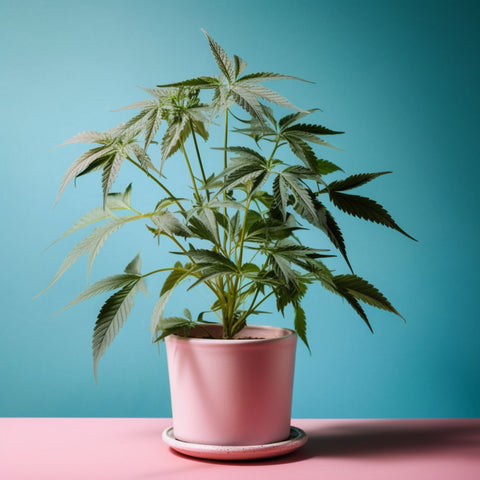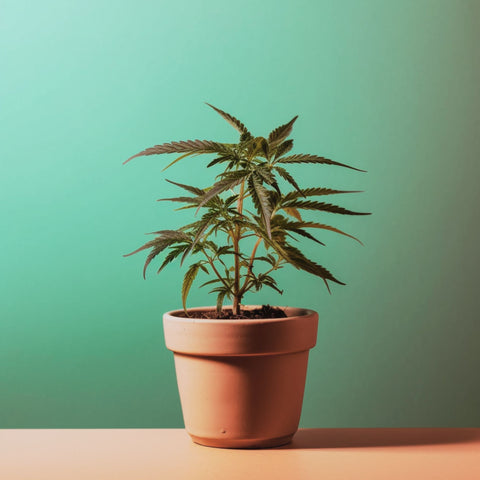The Intriguing World of Cannabis Ruderalis

Welcome to a deep dive into the captivating realm of Cannabis Ruderalis. This member of the cannabis family, while less renowned than its siblings, Cannabis Indica and Cannabis Sativa, is a treasure trove of unique characteristics and potential applications. Whether you're a cannabis enthusiast, a medical researcher, a cultivator, or a curious reader, this comprehensive guide will shed light on the fascinating world of Cannabis Ruderalis.
Cannabis Ruderalis, often called 'Ruderalis', is a robust plant species known for its unique auto-flowering properties. Unlike its more well-known counterparts, Ruderalis transitions from the vegetative to the flowering stage based on age rather than light exposure. This fascinating trait and its ability to thrive in harsh climates set Ruderalis apart from other cannabis species.
Understanding Cannabis Ruderalis is essential for several reasons. For breeders, the auto-flowering trait of Ruderalis offers a unique advantage, enabling the development of hybrid strains that flower independently of light cycles. For medical and recreational users, Ruderalis hybrids can provide diverse effects and benefits, thanks to the combination of Ruderalis genetics with those of other cannabis strains. For those with an environmental focus, the hardiness and low-maintenance nature of Ruderalis make it a sustainable choice in cannabis cultivation.
Tracing the Roots: Origins and History of Cannabis Ruderalis
Cannabis Ruderalis is believed to have originated in the harsh climates of Central and East and certain regions in Asia. The term 'ruderalis' comes from 'ruderal', a term in botany for plant species that are the first to colonise land disturbed by natural forces or human activity. Living up to its name, Ruderalis is a hardy plant, capable of thriving in challenging environments where other cannabis species might struggle.
Historically, Cannabis Ruderalis was not cultivated for recreational or medicinal use due to its low Tetrahydrocannabinol (THC) content, the psychoactive compound most commonly associated with the 'high' from cannabis. Instead, it was primarily valued for its fibre, which was used in the production of textiles, and for its seeds, which were used for nutrition and oil production.
Delving Deeper: Understanding Cannabis Ruderalis
Cannabis Ruderalis is a compact and sturdy plant, typically standing between 1 and 2.5 feet tall at harvest. This is considerably shorter than its Indica and Sativa counterparts, which can reach heights of several metres under optimal conditions. Ruderalis plants exhibit a rugged and shaggy growth pattern, with broad leaflets expressing a light green hue. The buds of the Ruderalis plant are smaller but chunky, supported by thick, robust stems.
Genetically, Cannabis Ruderalis is distinct from both Cannabis Indica and Cannabis Sativa. While all three species share a common ancestry, Ruderalis has evolved separately, adapting to the harsh climates and shorter growing seasons of its native regions. This has resulted in a plant with a unique genetic profile, including a lower THC content compared to Indica and Sativa. However, it's worth noting that Ruderalis is often used in breeding programs to create hybrids that combine the desirable traits of high THC or Cannabidiol (CBD) content with the hardiness and auto-flowering characteristics of Ruderalis.
The Autoflowering Trait: A Unique Property
Perhaps the most distinctive feature of Cannabis Ruderalis is its auto-flowering trait. Unlike Indica and Sativa plants, which transition from the vegetative to the flowering stage based on light cycles, Ruderalis makes this transition based on the age of the plant. Typically, Ruderalis plants begin to flower between 21 and 30 days after planting the seeds, regardless of the light cycle. This unique property is highly valued in the cultivation of cannabis, as it allows for more flexible and efficient growing operations. It's also why Ruderalis genetics are increasingly used to create auto-flowering hybrid strains.
The Art of Cultivation: Growing Cannabis Ruderalis

Cultivating Cannabis Ruderalis is a unique process, thanks to its auto-flowering trait. Unlike other cannabis species requiring specific light cycles to transition between vegetative and flowering stages, Ruderalis plants flower based on age. This means they can be grown year-round without the need to adjust light exposure.
While Ruderalis is naturally adapted to harsh climates, it can be cultivated in various environments, from indoor grow rooms to outdoor gardens. The key to successful Ruderalis cultivation lies in understanding its growth cycle. Since the plant automatically flowers after a few weeks, it's crucial to provide optimal growing conditions from the start. This includes well-draining soil, adequate water, and a nutrient-rich diet.
The Benefits of Growing Cannabis Ruderalis
Cultivating Cannabis Ruderalis offers several advantages, making it an attractive option for novice and experienced growers. First and foremost, the auto-flowering trait simplifies the cultivation process. As with non-auto-flowering strains, growers don't need to worry about adjusting light cycles or removing male plants to prevent pollination.
Secondly, the compact size of Ruderalis plants makes them ideal for small-scale and indoor growing operations. Despite their small stature, these plants can produce a decent yield, especially when grown under optimal conditions.
Lastly, the hardiness of Ruderalis means it's less susceptible to pests, diseases, and adverse weather conditions than other cannabis species. This resilience, combined with its auto-flowering nature, allows for multiple harvests in a year, even in regions with shorter growing seasons.
The Role of Cannabis Ruderalis in Hybridization
The unique characteristics of Cannabis Ruderalis, particularly its auto-flowering trait, have made it a valuable asset in cannabis breeding and hybridisation. By crossing Ruderalis strains with high-THC or high-CBD strains of Indica or Sativa, breeders can create hybrids that combine the best of both worlds.
The auto-flowering trait of Ruderalis is a dominant genetic feature, meaning it is often expressed in the first generation of hybrids. This allows breeders to create strains that flower automatically, regardless of light cycle, while still offering the potent effects or therapeutic benefits of their Indica or Sativa parent.
Moreover, the hardiness and resilience of Ruderalis can also be passed on to hybrid strains, making them more robust and easier to grow than their non-hybrid counterparts.
Popular Cannabis Ruderalis Hybrids
The use of Cannabis Ruderalis in hybridisation has led to the creation of numerous popular auto-flowering strains. One such example is the Lowryder strain, often considered the original auto-flowering strain. Lowryder was created by crossing a Ruderalis strain with Northern Lights #2 and William's Wonder, resulting in a compact plant with a short growth cycle and a decent THC content.
Another popular Ruderalis hybrid is the Royal Dwarf, a cross between Skunk and Ruderalis. This strain retains the potent effects and skunky aroma of its Skunk parent, while its compact size and auto-flowering trait are inherited from the Ruderalis side of the family.
Cannabis Ruderalis and the Environment

The cultivation of Cannabis Ruderalis can have a significantly lower environmental impact compared to other cannabis species. Its hardy nature and auto-flowering trait mean it requires less intensive care, potentially reducing the use of resources like water and energy. Furthermore, its resilience to pests and diseases can minimise the need for chemical pesticides, contributing to a healthier ecosystem.
Sustainability Aspects of Cannabis Ruderalis
From a sustainability perspective, Cannabis Ruderalis stands out as an environmentally friendly choice. Its ability to thrive in various climates and conditions reduces the need for artificial environmental control, leading to lower energy consumption. Additionally, the auto-flowering trait allows for multiple harvests in a single year, maximising yield from a single plant and reducing the need for new plantings.
Moreover, the potential uses of Cannabis Ruderalis extend beyond its psychoactive properties. Its fibrous stalks can be used to produce sustainable materials like hemp fibre, and its seeds are a source of nutritious food and oil. These factors and its low environmental impact make Cannabis Ruderalis a promising candidate for sustainable cannabis cultivation.
Medical and Recreational Uses of Cannabis Ruderalis
THC and CBD Content: A Brief Overview
Cannabis Ruderalis is unique in its chemical composition compared to its Indica and Sativa counterparts. It typically has a lower THC (Tetrahydrocannabinol) content, the psychoactive compound responsible for the 'high' associated with cannabis. However, Ruderalis often has a relatively high CBD (Cannabidiol) content, a non-psychoactive combination known for its potential therapeutic benefits.
Potential Medical Applications of Cannabis Ruderalis
The high CBD content of Cannabis Ruderalis has sparked interest in its potential medical applications. CBD has been studied for its potential role in managing various health conditions, including chronic pain, anxiety, epilepsy, and more. As such, Ruderalis strains and Ruderalis-derived hybrids may offer therapeutic benefits without the potent psychoactive effects associated with high-THC strains.
Moreover, the auto-flowering trait of Ruderalis has been utilised to create medical cannabis strains that can be harvested multiple times a year, ensuring a consistent supply of medical-grade cannabis.
Recreational Use and Effects of Cannabis Ruderalis
While Cannabis Ruderalis may not deliver the potent psychoactive effects sought after in recreational cannabis use due to its lower THC content, it's not without its appeal. The subtle, milder effects of Ruderalis strains can be desirable for those seeking a less intense experience. Additionally, Ruderalis hybrids, which combine the genetics of Ruderalis with high-THC Indica or Sativa strains, can offer a balanced blend of effects, making them a popular choice among recreational users.
The Future of Cannabis Ruderalis

Current Research and Developments
The unique properties of Cannabis Ruderalis have sparked a surge of interest in the scientific community. Current research is largely focused on exploring its genetic makeup, particularly the genes responsible for its auto-flowering trait. Understanding these genes could pave the way for new breeding techniques and the development of novel cannabis strains.
Additionally, studies are being conducted to further investigate the potential therapeutic benefits of Ruderalis strains, given their high CBD content. This research could lead to the development of new medical treatments and therapies.
Potential Future Applications and Uses
Looking to the future, the potential applications and uses of Cannabis Ruderalis are vast. In the field of medicine, Ruderalis strains could play a significant role in the production of CBD-rich cannabis products. In recreational use, Ruderalis hybrids offer a unique blend of effects catering to a wide range of preferences.
Furthermore, the sustainability aspects of Cannabis Ruderalis cultivation align with a growing emphasis on environmentally friendly practices in agriculture. As we strive towards a more sustainable future, the role of resilient, low-impact crops like Cannabis Ruderalis is set to become increasingly important.
Cannabis Ruderalis and the Law

The legal status of Cannabis Ruderalis varies widely across the globe, much like its Indica and Sativa counterparts. In some regions, the cultivation and use of cannabis, regardless of the species, are strictly regulated or outright banned. However, in other areas, laws have been relaxed or modified to allow for the cultivation of cannabis for medical or research purposes.
In Australia, for instance, the cultivation of cannabis for medicinal purposes is legal with the appropriate licenses and permits. This includes Cannabis Ruderalis, mainly when used to create CBD-rich medical cannabis products.
How it Compares to the Legal Status of Other Cannabis Species
Regarding the law, Cannabis Ruderalis is generally treated the same as other cannabis species. This is because most legislation does not differentiate between Indica, Sativa, and Ruderalis but focuses on the plant's psychoactive component, THC.
However, it's worth noting that the lower THC content of Ruderalis may impact its legal status in regions where laws are based on THC concentration. As always, it's crucial to understand and comply with the specific cannabis laws in your area.
Conclusion
In this comprehensive guide, we've journeyed through the fascinating world of Cannabis Ruderalis, exploring its origins, unique characteristics, cultivation methods, and potential uses. We've delved into its role in hybridisation, environmental impact, and promising future.
Cannabis Ruderalis, with its auto-flowering trait and resilience, holds immense potential in cannabis cultivation, medical research, and sustainable agriculture. As we continue to explore and understand this remarkable plant, its importance in the cannabis landscape is set to grow.
In conclusion, Cannabis Ruderalis is more than just a lesser-known member of the cannabis family. It's a testament to nature's incredible diversity and potential, and a promising player in the future of cannabis.





